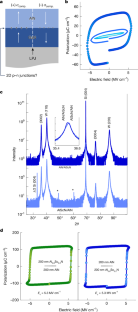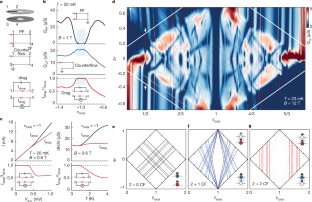2025-01-08 ペンシルベニア州立大学(PennState)
<関連情報>
- https://www.psu.edu/news/earth-and-mineral-sciences/story/proximity-effect-method-allows-advanced-materials-gain-new
- https://www.nature.com/articles/s41586-024-08295-y
ウルツ鉱型ヘテロ構造における近接強誘電性 Proximity ferroelectricity in wurtzite heterostructures
Chloe H. Skidmore,R. Jackson Spurling,John Hayden,Steven M. Baksa,Drew Behrendt,Devin Goodling,Joshua L. Nordlander,Albert Suceava,Joseph Casamento,Betul Akkopru-Akgun,Sebastian Calderon,Ismaila Dabo,Venkatraman Gopalan,Kyle P. Kelley,Andrew M. Rappe,Susan Trolier-McKinstry,Elizabeth C. Dickey & Jon-Paul Maria
Nature Published:08 January 2025
DOI:https://doi.org/10.1038/s41586-024-08295-y

Abstract
Proximity ferroelectricity is an interface-associated phenomenon in electric-field-driven polarization reversal in a non-ferroelectric polar material induced by one or more adjacent ferroelectric materials. Here we report proximity ferroelectricity in wurtzite ferroelectric heterostructures. In the present case, the non-ferroelectric layers are AlN and ZnO, whereas the ferroelectric layers are Al1−xBxN, Al1−xScxN and Zn1−xMgxO. The layered structures include nitride–nitride, oxide–oxide and nitride–oxide stacks that feature two-layer (asymmetric) and three-layer (symmetric) configurations1,2,3. Ferroelectric switching in both layers is validated by multimodal characterization methods, including polarization hysteresis, anisotropic chemical etching, second harmonic generation, piezo response force microscopy, electromechanical testing and atomic resolution polarization orientation imaging in real space by scanning transmission electron microscopy. We present a physical switching model in which antipolar nuclei originate in the ferroelectric layer and propagate towards the internal non-ferroelectric interface. The domain wall leading edge produces elastic and electric fields that extend beyond the interface at close proximity, reducing the switching barrier in the non-ferroelectric layer, and allowing complete domain propagation without breakdown. Density functional theory calculations of polymorph energies, reversal barriers and domain wall energies support this model. Proximity ferroelectricity enables polarization reversal in wurtzites without the chemical or structural disorder that accompanies elemental substitution, opening new questions and opportunities regarding interface-based ferroelectricity.



